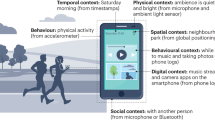Abstract
Three tools for acquiring data about people, their behavior, and their use of technology in natural settings are described: (1) a context-aware experience sampling tool, (2) a ubiquitous sensing system that detects environmental changes, and (3) an image-based experience sampling system. We discuss how these tools provide researchers with a flexible toolkit for collecting data on activity in homes and workplaces, particularly when used in combination. We outline several ongoing studies to illustrate the versatility of these tools. Two of the tools are currently available to other researchers to use.
Access this chapter
Tax calculation will be finalised at checkout
Purchases are for personal use only
Preview
Unable to display preview. Download preview PDF.
Similar content being viewed by others
References
Abowd, G.D.: Personal communication. Director of the Aware- Home Initiative. Georgia Insitute of Technology (November 2002)
Ainsworth, B.E., Haskell, W.L., Whitt, M.C., Irwin, M.L., Swartz, A.M., Strath, S.J., O’Brien Jr., W.L., Bassett, D.R., Schmitz, K.H., Emplaincourt, P.O., Jacobs Jr., D.R., Leon, A.S.: Compendium of physical activities: An update of activity codes and MET intensities. Medicine & Science in Sports & Exercise, 32(9 Suppl), S498–504 (2000)
Alwan, M.: Personal communication. Assistant Professor, University of Virginia (November 2002)
Barger, T., Alwan, M., Kell, S., Turner, B., Wood, S., Naidu, A.: Objective remote assessment of activities of daily living: Analysis of meal preparation patterns. Poster presentation, Medical Automation Research Center. University of Virginia Health System (2002)
Barrett, L.F., Barrett, D.J.: An introduction to computerized experience sampling in psychology. Social Science Computer Review 19(2), 175–185 (2001)
CAES. Context-Aware Experience Sampling Website, Access date: January 15 (2003), http://caes.sourceforge.net
Castro, P., Mani, M., Mathur, S., Muntz, R.: Managing context for internet video conferences: The multimedia internet recorder and archive. Multimedia and Computer Networks (2000)
Coen, M.: Design principles for intelligent environments. In: Proceedings of the Fifteenth National Conference on Artificial Intelligence. AAAI Press, Menlo Park (1998)
Collier, J., Collier, M.: Visual Anthropology: Photography as a Research Method. University of New Mexico Press, Albuquerque (1986); rev. and expanded edition
Consolvo, S., Arnstein, L., Franza, B.R.: User study techniques in the design and evaluation of a ubicomp environment. In: Borriello, G., Holmquist, L.E. (eds.) Proceedings of the Fourth International Conference on Ubiquitous Computing, pp. 73–90. Springer, Berlin (2002)
Csikszentmihalyi, M., Larson, R.: Validity and reliability of the Experience- Sampling Method. The Journal of Nervous and Mental Disease 175(9), 526–536 (1987)
Hollar, S.: COTS Dust. Ph.D. thesis, University of California, Berkeley (2001)
Hudson, J.M., Christensen, J., Kellogg, W.A., Erickson, T.: ‘I’d Be Overwhelmed, But It’s Just One More Thing to Do: Availability and Interruption in Research Management. In: Proceedings of the Confererence on Human Factors in Computing Systems. ACM Press, New York (2002)
Hudson, S.E., Fogarty, J., Atkeson, C.G., Avrahami, D., Forlizzi, J., Kiesler, S., Lee, J.C., Yang, J.: Predicting human interruptability with sensors: A Wizard of Oz feasibility study. In: Proceedings of the Conference on Human Factors and Computing. ACM Press, New York (2003)
Intille, S.S.: Designing a Home of the Future. IEEE Pervasive Computing, 80–86 (April-June 2002)
Intille, S.S., Kukla, C., Ma, X.: Eliciting user preferences using image-based experience sampling and reflection. In: Proceedings of the Conference on Computer Human Interface Short Abstracts, pp. 738–739. ACM Press, New York (2002)
Intille, S.S., Rondoni, J., Kukla, C., Anacona, I., Bao, L.: A context-aware experience sampling tool. In: Proceedings of the Conference on Human Factors and Computing Systems: Extended Abstracts. ACM Press, New York (2003)
Kahn, J.M., Katz, R.H., Pister, K.S.J.: Mobile networking for Smart Dust. In: ACM/IEEE International Conference on Mobile Computing and Networking (MobiCom 1999) (1999)
Kasten, O., Langheinrich, M.: First experiences with Bluetooth in the Smart-Its distributed sensor network. In: Workshop on Ubiquitous Computing and Communications, PACT (2001)
Mahajan, V., Wind, J.: New product models: Practice, shortcomings and desired improvements. The Journal of Product Innovation Management 9(2), 128–139 (1992)
Mainwaring, A., Polastre, J., Szewczyk, R., Culler, D., Anderson, J.: Wireless sensor networks for habitat monitoring. In: Proceedings of the ACM International Workshop on Wireless Sensor Networks and Applications (2002)
Mozer, M.: The Neural Network House: an environment that adapts to its inhabitants. In: Proceedings of the AAAI Spring Symposium on Intelligent Environments, Technical Report SS-98-02, pp. 110–114. AAAI Press, Menlo Park (1998)
Robinson, J.P.: The validity and reliability of diaries versus alternative time use measures. In: Juster, F.T., Stafford, F.P. (eds.) Time Goods and Well-Being, Ann Arbor, MI, pp. 33–62 (1999)
Rodin, J., Langer, E.J.: Long-term effects of a control-relevant intervention with the institutionalized aged. Journal of Personality and Social Psychology 35(12), 897–902 (1977)
Schèon, D.A.: The Reflective Practitioner: How Professionals Think in Action. Basic Books, New York (1983)
Stone, A.A., Shiffman, S.: Ecological momentary assessment (EMA) in behavioral medicine. Annals of Behavioral Medicine 16(3), 199–202 (1994)
Szalai, S.: The Use of Time. In: Daily Activities of Urban and Suburban Populations in Twelve Countries. Mouton, The Hague (1973)
Author information
Authors and Affiliations
Editor information
Editors and Affiliations
Rights and permissions
Copyright information
© 2003 Springer-Verlag Berlin Heidelberg
About this paper
Cite this paper
Intille, S.S. et al. (2003). Tools for Studying Behavior and Technology in Natural Settings. In: Dey, A.K., Schmidt, A., McCarthy, J.F. (eds) UbiComp 2003: Ubiquitous Computing. UbiComp 2003. Lecture Notes in Computer Science, vol 2864. Springer, Berlin, Heidelberg. https://doi.org/10.1007/978-3-540-39653-6_13
Download citation
DOI: https://doi.org/10.1007/978-3-540-39653-6_13
Publisher Name: Springer, Berlin, Heidelberg
Print ISBN: 978-3-540-20301-8
Online ISBN: 978-3-540-39653-6
eBook Packages: Springer Book Archive




